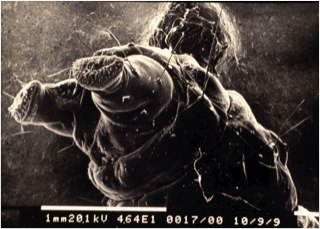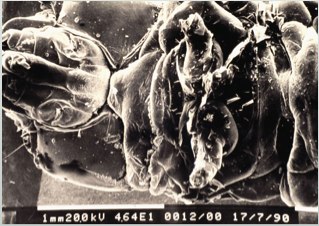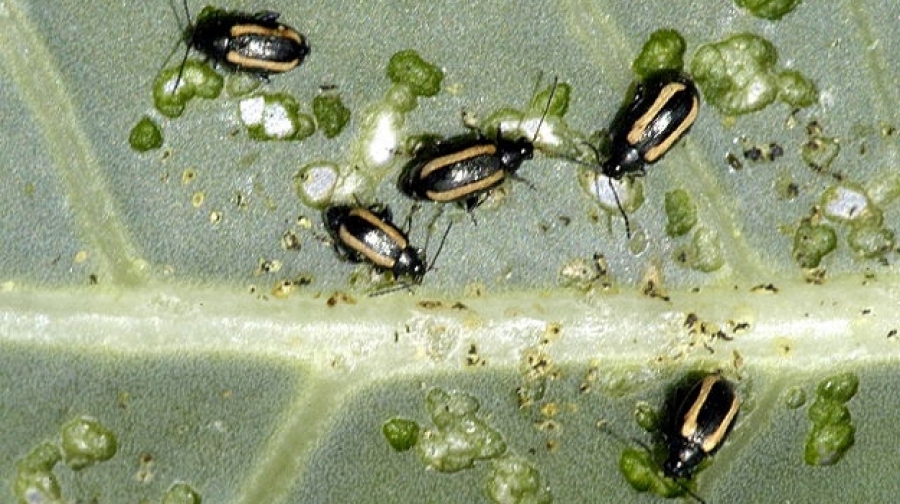Rock Dust and Pest Control
Among organic methods of pest control, rock dust is one of the safest for people, soil, and plants.
Modern science is only beginning to understand the benefits of nature’s original soil amendment: rock dust. This inexpensive, abundant, locally available material could prove instrumental in rebuilding the world’s soils. The broad-spectrum minerals in rock dust provide major, minor, and trace nutrients that support vigorous plants above the soil and extensive biological life within the soil. Well-nourished microorganisms are the vital link between organic matter and high-quality humus, and humus is the very foundation of soil fertility. A humus-rich, remineralized soil is truly fertile; such a soil makes healthy plants, which make healthy food, which makes healthy people.
Rock dust has attracted agricultural attention in recent years because of repeated experiments that demonstrate its efficacy. In Scotland, local quarry dust revitalized the initially lifeless soil of the SEER Centre, leading to sustained bumper crops of giant, nutrient-dense vegetables. In Costa Rica, Jatropha trees showed increased yield and vigor after applications of volcanic rock dust from a nearby quarry. In the United States, land amended with glacial moraine gravel dust produced over twice as much corn as chemically fertilized land. In this case, the improvement in quality surpassed the increase in quantity—compared to a conventionally grown counterpart, this corn was significantly higher in protein, calcium, phosphorus, magnesium, and potassium.
Chemical fertilizers are an abysmal substitute for broad-spectrum mineral nutrition. High-quality rock dust provides the nutrients that plants need in a balanced, natural form. In The New Organic Grower, market gardener Eliot Coleman explains that finely ground rock powders approximate “the composition of highly fertile, unweathered ‘young’ soils… [that] provide large amounts of essential plant nutrients.”[i] Instead of bombarding the plants and the soil with concentrated, soluble chemicals, rock dust works in concert with the soil’s biological processes to release long-lasting balanced nutrition.
Local rock dust can also be a favorable alternative to expensive, unbalanced, or over-refined organic fertilizers. Greensand, for example, is an excellent source of potassium and trace minerals. The price, however, can be prohibitive: an acre’s worth of greensand could easily cost $400. A trip to the local quarry might procure the same amount of gravel dust for five dollars. Blood meal, bone meal, alfalfa meal, and other organic fertilizers share some of the limitations of chemical fertilizers and may carry toxic residues. For general-purpose use, rock dust is the preferred option.
There is growing respect for rock dust as a soil amendment, but there is comparatively minor recognition of rock dust’s potential for pest control. According to Joanna Campe, executive director of Remineralize the Earth, “In the short-term, very fine dust sprayed directly on plants and trees has been shown to deter insect infestations very effectively, and in the long-term, remineralized plants will not be plagued by insects as they become healthier and more insect resistant.” Rock dust undoubtedly contributes to long-term pest resistance by promoting healthy plants that withstand disease and insect pressure. But even in the most fertile soils, insects sometimes gain the upper hand; in these situations, rock dust can be an effective, safe, and ecologically sound approach to mitigating pest damage.
The Limitations of Common Alternatives to Synthetic Pesticides
Opposition to synthetic pesticides is ever strengthening as research continues to expose the harmful effects of these agricultural poisons. However, some organic alternatives come with their own complement of health and environmental concerns; others can be expensive, impractical, or woefully ineffective.
Natural insecticides include rotenone, pyrethrum, and Bacillus thuringiensis (among many others). Rotenone and pyrethrum are plant-derived contact poisons that are moderately toxic to mammals and have “the power to upset ecological balance as much as the worst chemical sprays.”[ii] Bacillus thuringiensis is considered safe for humans and the environment, but each variant is only effective against a particular subset of insects.
Physical controls achieve greater safety at the expense of practicality. Old-fashioned hand-picking is a feasible option under certain conditions, but this approach is quickly thwarted when the insects get too small or the infestation gets too large. Many flying pests will be impeded by a carefully installed floating row cover, but weeding, watering, mulching, air circulation, and sunlight are similarly impeded. Vacuum collection requires expensive equipment and is applicable only to plants of a certain shape and size.
Each particular pest control technique has its imperfections, but more importantly, any approach that focuses on killing insects carries a fundamental weakness: it encourages the proliferation of resistant pests. A farmer spraying insecticides on his fields is unintentionally breeding weak plants and strong insects. It is clear, then, that any responsible approach to short-term pest control must minimize this effect, and to the extent possible, it should be safe, practical, and cheap. Rock dust emerges from these criteria as a promising option.
Finely Ground Rock Dust as Short-Term Pest Control
Many people are familiar with using diatomaceous earth (DE) for pest control, but comparatively few are aware that finely ground rock dust can be similar in efficacy and preferable in other aspects. Rock powder and DE fit into the category of “inert dusts,” which were identified as effective insecticides by the end of the nineteenth century.[iii] Inert dusts operate primarily by absorbing or disrupting the waxy superficial layer that prevents insects from rapidly drying out.[iv] They also physically repel pests, disrupt their reproductive cycles, and abrade them.[v]
Bob Cannard, whose remineralized soil grows produce of such exceptional quality that he was chosen by Alice Waters to supply fruits and vegetables to her Chez Panisse restaurant, explains that finely crushed rock contains about 25% silicates; when applied directly to the plant, these small particles disable and discourage insects by causing various forms of mechanical discomfort. Rick Knoll of Knoll Farms has an incredible variety of curative uses for rock dust, from protecting heat-stressed fig trees to enhancing his compost tea. His experience confirms that rock dust of the appropriate consistency is a valuable alternative to harmful pesticides. “If you’re trying to grow arugula in the summertime and you get flea beetles on it, you can dust the plants….Overnight, essentially, the flea beetles will leave.”

This microscopic photo shows a rock dusted insect disabled as the dust penetrates segments and organs.

Insects are deterred by the rock dust, creating a healthy balance rather than wiping them all out.
Rock dust exhibits moderate efficacy against many insect pests. Moderation is unacceptable for conventional agriculture, which generally relies on noxious chemicals that must eradicate insects before they decimate the malnourished crops. For sustainable agriculture, however, moderate efficacy should be the preference. Rock dust is capable of destroying and disabling insects to an extent that will limit their population and reduce crop damage. It does not obliterate insect life in a way that produces ecological imbalance and rapidly breeds resistant pests. This moderate efficacy facilitates the creation of a healthy agricultural ecosystem that will gradually require fewer palliative solutions to pest problems.
Among organic methods of pest control, rock dust is one of the safest for people, soil, and plants. Inert dusts can cause respiratory complications resulting from excessive inhalation; the risk is mild, though, and is more pronounced in DE than in rock dust because DE contains more crystalline silica.[vi] Typical outdoor use poses minimal danger, and this could be easily eliminated by wearing a respirator. And it should be no surprise that rock dust is safe for the soil—it is, after all, an excellent soil amendment. Furthermore, according to Bob Cannard, plants “breathe in” significant mineral nutrition through the stomata on their leaf surfaces, resulting in a “very speedy response from foliar applications of finely crushed rock.” This value as a fertilizer, along with its low cost and local availability, makes rock dust preferable to DE.
Rock Dust as Long-Term Pest Control
The organic movement has long emphasized the principal importance of plant health in preventing, rather than correcting, pest problems. This is still a rather outlandish concept in an agricultural world dominated by a “treat the symptom” mentality. It is also largely foreign to a society that increasingly seeks robust health from allopathic medicine instead of from fresh, nutrient-dense foods that are free of toxic residues. In the words of organic blueberry farmer Bob Wilt, mineral-rich soil growing mineral-rich food is “exactly what this country needs for a health care plan.” Awareness is growing, however, as research continues to illuminate the relationship between fertile, remineralized soil and pest-resistant crops.
Insect pests can appear to be a glaring exception to the balance and logic of nature, especially to a desperate gardener gazing into a pumpkin patch that has been ravaged by squash bugs, or to an organic farmer whose field of sweet corn is infested with earworms. Nevertheless, destructive insects and diseases fulfill a vital role in nature’s cycle: they limit the reproduction of weak, malnourished plants. Dan Kittredge, director of the Real Food Campaign, describes agricultural pests as biological recyclers that encourage healthy crops by destroying unhealthy plants and returning their nutrients to the soil.
Rock dust is perhaps the ideal soil amendment for promoting improved immunity to pests and disease. Dan Kittredge explains that the silica in rock dust strengthens a plant’s cell walls, making the cells less susceptible to the penetrating hyphae of pathogenic fungi. He also emphasizes the role of rock dust’s abundant mineral nutrition, which enables the plant to properly synthesize complete proteins: “Insects do not have the capacity to break down complete proteins.” If a plant’s tissues are composed of properly formed complete proteins that are replenished by ongoing vigorous growth, hungry insects will look elsewhere. “Plants have complete immunological systems,” Bob Cannard insists, but to function properly these immune systems need full support from the plant’s environment. Rock dust, he continues, is the best source of the “mineral compounds that are the catalysts of all enzymatic systems that allow the plant to function properly.”
Rock dust is also a natural, balanced source of trace minerals, which are now recognized as essential to plant health and vigor despite the small quantities involved. Copper, for example, supports the synthesis of Vitamin A and Vitamin C, which help the plant (and the person eating the plant) to resist disease.[vii] Without molybdenum, a plant cannot properly convert nitrogen into protein;[viii] this is particularly significant in view of the theory that points to free nitrogen and complete protein synthesis as dominant factors in pest resistance.[ix]
Many other elements are equally necessary, and providing them all in isolated or synthetic form is impractical and risky. Even basic organic practices will be inadequate if compost, mulch, and manure are made from organic matter that is deficient in trace minerals. Bob Wilt of Sunset Valley Organics grows organic blueberries of unsurpassed flavor and nutritional value—he is also a staunch advocate of soil mineralization, which he sees as essential to the health of his soil and the quality of his berries. “Minerals are very important for all enzymes to function. If indeed there is a mineral missing, the plant wants to substitute. They will take something of lesser value if they have to. When that happens, you start getting diseases.” Wilt believes that plants with a high level of soluble solids in their sap will not be seriously afflicted by diseases or insects, and he identifies one way to encourage this condition: “You got to have the minerals. It’s all about the minerals.” The sensible way to ensure the availability of major nutrients and broad-spectrum minerals is to follow nature’s example by maintaining high levels of humus, fostering soil biology, and periodically incorporating pulverized rock.
Research and experimentation are needed to expand and refine our practical understanding of rock dust’s potential for controlling pests. Is rock dust effective in the orchard as well as the garden? Does the efficacy vary according to the method of application? Are certain types of rock more effective against certain types of insects? Such information is desperately needed in a world where farmers, gardeners, and orchardists must often choose between spraying poisons and losing a crop. Rock dust may expand their options by offering a safe, inexpensive, and effective form of pest control that is rooted in the simple wisdom of natural processes.
[i] Eliot Coleman, The New Organic Grower (White River Junction, VT: Chelsea Green Publishing, 1995), 101-2[ii] Michael Phillips, The Apple Grower (White River Junction, VT: Chelsea Green Publishing, 2005), 219
[iii] William Quarles, “Diatomaceous Earth for Pest Control,” The IPM Practitioner 14 (May/June 1992)
[iv] Walter Ebeling, “Sorptive Dusts for Pest Control,” Annual Review of Entomology 16 (1971)
[v] Ibid.; Bhadriraju Subramanyam and Rennie Roesli, “Inert Dusts,” Kansas State University Lecture, http://www.ksre.ksu.edu/grsc_subi/Teaching/GRSC651/GRSC651_Courses_Material/lecture_slides/GRSC651_lect_20(1)_Inert_Dusts.pdf, 20-21
[vi] Bhadriraju Subramanyam and Rennie Roesli, “Inert Dusts,” Kansas State University Lecture, http://www.ksre.ksu.edu/grsc_subi/Teaching/GRSC651/GRSC651_Courses_Material/lecture_slides/GRSC651_lect_20(1)_Inert_Dusts.pdf, 47
[vii] Michael Phillips, The Apple Grower (White River Junction, VT: Chelsea Green Publishing, 2005), 59
[viii] Asilomar Workshop on the Geochemical Environment in Relation to Health and Disease, Geochemistry and the Environment: The Relation of Selected Trace Minerals to Health and Disease (National Research Council, 1972), 77
[ix] Eliot Coleman, The New Organic Grower (White River Junction, VT: Chelsea Green Publishing, 1995), 176
Support us on Patreon
Thank you for joining us today! Please become a member of RTE and support us on Patreon. Unlike many larger organizations, we work with a team of determined and passionate volunteers to get our message out. We aim to continue to increase the awareness of remineralization to initiate projects across the globe that remineralize soils, grow nutrient dense food, regenerate our forests’ and stabilize the climate – with your help! If you can, please support us on a monthly basis from just $2, rest assured that you are making a big impact every single month in support of our mission. Thank you!








Joshua Brock
September 10, 2015 (1:28 pm)
Great article…thanks!
I came across it as I was searching for information about pulverizing sandstone. Our farm is in Northcentral PA and we are “blessed” with an abundance of small, midsized and large rocks in our fields. In years past, we had other farmers lease and grow their crops in these fields, however we are now making use of them ourselves for grain and covercrop rotations. As this is our first time working the land, we’ve noticed just how rocky those sections are. I don’t recall our leasing farmers using rock rakes or pickers…I know they big the huge stones out, but they must’ve made do with the soils after they plowed then disced them.
I’d like to get our soils to the next level of nutrient density and workability. I am looking at rock pickers for rent…and if I see a used one that’s reasonable for purchase I may get it. However I’ve seen large rock pickers that also pulverize the rocks and drop the sand back to the soil. Our rocks are primarily sandstone.
I’m curious if the day comes I can find one of these machines to pulverize the sandstone and then I work that back into the soil, will that have the benefits of the rock dust you mention? Is rock dust a mixture of various rocks…if I try this with our sandstone, could I be causing issues down the road? We are a certified naturally Grown (CNG) farm and I’d like to incorporate as many organic, long term (non-chemical) means into our processes going forward as I can.
Thanks!
Joshua
Hoffman Appalachian Farm
Saint Marys, Pennsylvania
Joanna Campe
February 20, 2017 (9:33 pm)
If you are interested in a small portable rock grinder and also possibly larger models, please contact us through the website.
Silas Thomson
June 2, 2023 (5:07 am)
Hi Joshua, glad to hear you’re concerned and interesting in looking after and regenerating your soil. To answer your question, the rockdust we used here in Scotland is volcanic, basalt to be exact, not every type of rock will be beneficial, sandstone is mostly sand, and kind of volcanic rock is better, things like granites should be avoided, I hope this helps, a late reply is better than none, regards, Silas
Dr Sreekumar
November 21, 2015 (11:34 am)
Can we dust on cows which have tick infestation.
Have u done any trials.
Joanna Campe
February 20, 2017 (9:30 pm)
I have not heard of any trials along those lines, but I think it would be wroth a try.There are many ways that cows benefit from remineralization, both remineralizing the great grazing area and giving rock dust as a supplement to the cows. It can also take away odors of liquid manure.
Redmond
August 13, 2024 (9:38 am)
This is such a cool concept. I had no idea that rock dust could actually be a bug repellant and even used in larger scale pest control applications! Super cool
Kirkland
November 3, 2024 (10:22 pm)
Amazing concept here and I definitely didn’t know that about rock dust! Awesome post!